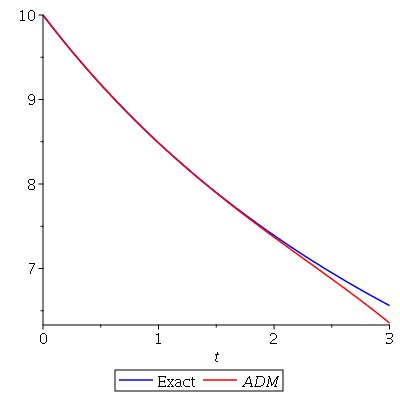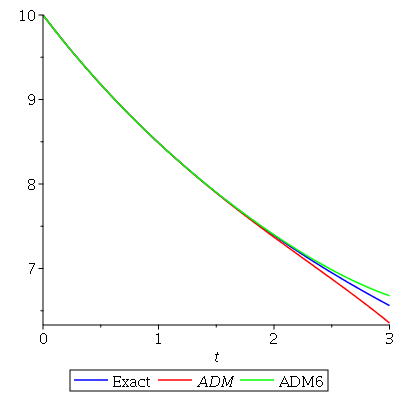Adomian Decomposition Method
This tutorial surves as an introduction to the computer algebra system Maple, created by MapleSoft ©. It is made solely for the purpose of education. This tutorial assumes that you have a working knowledge of basic Maple functionality. It is recommended to switch to Maple Classic so all codes will have the same appearance, regardless of the version used. To achieve this, follow the following steps:
- when Maple is open, select "tools" at the top, and then "Options;"
- click on the "Display" tab, and in the "Input display" select "Maple Notation;"
- click on the "Interface" tab and in the "Default format for new worksheets" select "Worksheet;"
- go to the bottom of the "Options" menu and click on the "Apply Globally."
- Now close Maple and open it again
Usually, the same algorithm can be implemented in many different ways to accomplish the same task. As a result, this tutorial may introduce several different commands (or sets of commands) to do the same thing. It is always good to be aware of these alternate pathways; however, you are welcome to pick up any approach whatever you like the best .
Finally, the commands in this tutorial are all written in red text (as Maple input), while Maple output is in blue, which means that the output is in 2D output style. You can copy and paste all commands into Maple, change the parameters and run them. You, as the user, are free to use the mw files and scripts to your needs, and have the rights to distribute this tutorial and refer to this tutorial as long as this tutorial is accredited appropriately. The tutorial accompanies the textbook Applied Differential Equations. The Primary Course by Vladimir Dobrushkin, CRC Press, 2015; http://www.crcpress.com/product/isbn/9781439851043.
Return to computing page for the first course APMA0330
Return to computing page for the second course APMA0340
Return to Maple tutorial for the first course (APMA0330)
Return to Maple tutorial for the second course (APMA0340)
Return to the main page for the course APMA0340
Return to the main page for the course APMA0330
Return to Numerical Methods
Adomian Decomposition Method
The Adomian decomposition method (ADM) is a semi-analytical method for solving ordinary and partial nonlinear differential equations. The method was developed from the 1970s to the 1990s by an American mathematician and aerospace engineer of Armenian descent George Adomian (1922-1996), chair of the Center for Applied Mathematics at the University of Georgia. The crucial aspect of the method is employment of the "Adomian polynomials" to represent the nonlinear portion of the equation as a convergent series with respect to these polynomials, without actual linearization of the system. These polynomials mathematically generalize Maclaurin series about an arbitrary external parameter, which gives the solution method more flexibility than direct Taylor series expansion.Let me introduce some scientists (in alphabetic order) who contributed and greatly improved Adomian Decomposition Method to make it available to mathematical and engineering community.
Dr. George Adomian (1922--1996) was an American mathematician, theoretical physicist, and electrical engineer of Armenian descent. He received his Ph.D. degree from UCLA. He first proposed and considerably developed the Adomian Decomposition Method (ADM) for solving nonlinear differential equations, ordinary, and partial. He was a professor of mathematics at the University of Georgia, the founder and chief scientist of General Analytics Corporation, a winner of the 1989 Richard Bellman Prize for outstanding contributions to nonlinear stochastic analysis, and a National Academy of Sciences Scholar 1988. He is the author of eight books on and over three hundred journal papers. Dr. Adomian was the Radar Officer (naval rank of Lieutenant, the equivalent of a Captain in the Army by direct commission) aboard the USS Antietam (CV-36), and served in the Pacific Theater of Operations during the Second World War. He also attended the secret radar school at MIT which trained the first radar officers for the U.S. Navy. Dr. Yves Cherruault (1937--2010) was a French mathematician. He received his Ph.D. degree from the University of Paris. He was a professor of mathematics at the University Pierre et Marie Curie, Paris, and the Director of MÉDIMAT (Laboratory of Mathematics Applied to Biomedicine). Professor Cherruault is one of the founders of the field of Biomathematics and an author of seven books and over two hundred journal papers. Dr. Cherruault developed some of the convergence theorems of the ADM. Dr. Jun-Sheng Duan is a Chinese applied mathematician and computer scientists born in Inner Mongolia, China, in 1965. He received his Ph.D. degree from Shandong University, China. He has extensive contributions to solutions of differential equations in mathematical physics and engineering using ADM and the Modified Decomposition Method (MDM) in collaboration with Drs. Rach and Wazwaz. He has been a professor of mathematics at the Inner Mongolia Polytechnic University, the Tianjin University of Commerce, and currently at the School of Sciences, Shanghai Institute of Technology, China. He is the author of more than eighty journal papers. Dr. Duan is an outstanding player of wei qi (the Chinese “game of go”), and ping-pong (table tennis). He enjoys photography and traveling. Dr. Randolph Rach is a retired Army veteran and formerly a Senior Engineer at Microwave Laboratories Inc. His experience includes research and development in microwave electronics and traveling-wave tube technology, and his research interests span nonlinear system analysis, nonlinear ordinary and partial differential equations, nonlinear integral equations and nonlinear boundary value problems. He published more than one hundred and thirty papers in applied mathematics, and he is an early contributor to the ADM. Dr. Rach’s fundamental theorems established the basis for the early development of ADM. He was also the first to propose the MDM. His past and current research continue to advance the state of the art of ADM/MDM. Dr. Sergio E. Serrano was born in Santander (Colombia) in 1953. He is a professor of environmental engineering, hydrologic science, applied mathematics, and philosophy at Temple University in Philadelphia. He received his Ph.D. degree at the University of Waterloo (Canada). He has more than one hundred research publications in international science, engineering, and mathematical journals. He is also the author of eight books in environmental engineering, statistics, philosophy, and psychology. Dr. Serrano has been awarded four times with nationally-competitive research grants by the National Science Foundation, Washington, DC. Using adaptations and modifications of the ADM, he has developed hundreds of practical engineering models of flood wave propagation, contaminant transport, and groundwater flow in irregular geometries. Dr. Serrano has a passion for hiking. In 1973, he explored on foot the rain forest of the Darien Sierra from Acandi (Colombia) to Yaviza (Panama). He plays the recorder (Renaissance flute). He enjoys alchemy, archaeology, home wine making, herbal medicine, and cooking. He believes that the joy of meaningful living, and meaningful relationships, can be found in the simplicity of everyday life. He lives in Philadelphia with his wife of thirty years and his daughter. Dr. Abdul-Majid Wazwaz is a Professor of Mathematics at Saint Xavier University in Chicago. He received his Ph.D. from the University if Illinois at Chicago. He was the author and co-author of more than four hundred and fifty papers in applied mathematics and mathematical physics. He is the author of five books on the subjects of discrete mathematics, integral equations and partial differential equations. He has contributed extensively to theoretical advances in solitary waves theory, the ADM, and other computational methods. He is a member of the editorial board of the journals Nonlinear Dynamics (Springer) and Physica Scripta (IOP). For these three years in a row, 2014, 2015, and 2016, Thomas Reuters granted him three different badges for being a “Highly Cited Researcher.”We show how the method works in the series of examples. Since the Adomian method has its roots in quantum mechnaics and operator methods, we need to reconsider our old friend---the derivative operator. It is convenient to set a special symbol for the derivative operator, which is naturally denoted by \( \texttt{D} = {\text d} / {\text d} x . \) Its inverse is studied in calculus, and we denote it as
Example. Let us take a constant function \( y(x) \equiv 1 , \) then
Example. We start with a simple initial value problem for linear equation:
Example. Our next example is also related to the linear differential equation, but now we consider variable coefficient nonhomogeneous equation:
Table[y[n, x], {n, 0, 6}]
Do[y[n, x_] =
f[x] /. First @ DSolve[{f'[x] == -2*x*y[n - 1, x], f[1] == 0}, f, x], {n, 1, 5}]
phi[x_] := Simplify[Sum[y[n, x], {n, 0, 5}]]
Plot[{z[x], phi[x]}, {x, 1, 2}, PlotStyle -> {{Thick, Blue}, {Thick, Orange}}]

Now we turn our attention to initial value problems for nonlinear equations such as
Example. We apply Adomian decomposition method to find approximate solution to the initial value problem for logistic equation:
N:=y->y^2: #Nonlinear term
A[0]:=N(y0):
0.02*int(y[0](t),t)-0.02*int(A[0],t):
y[1]:=unapply(%,t):
Nt:=5:
for n from 1 to Nt do
diff( N(sum(y[m](t)*lambda^m,m=0..n)),lambda$n)/n!:
A[n]:=subs(lambda=0,%);
0.02*int(y[n](t),t)-0.02*int(A[n],t):
y[n+1]:=unapply(%,t);
end do:
sum(y[i](t),i=0..Nt):
phi:=unapply(%,t): #ADM approximate solution
Y:=t->10*exp(t/50)/(10*exp(t/50)-9): #Exact solution
Then we plot the exact solution in blue and ADM approximation in red: y0:=10: T:=3:
g1:=plot(Y(t),t=0..T,color=blue,legend="Exact "):
g2:=plot(phi(t),t=0..T,color=red,legend=ADM):
plots[display](g1,g2);
To see how ADM appfroximation works, we add one more polynomial to obtain ADM six term approximation. g3 := plot(phi(t)+55506619*t^6/(125*10^9), t = 0 .. T, color = green, legend = "ADM6")
plots[display](g1, g2, g3)
 |
 |
Example. Consider the initial value problem for the integro-differential equation
A[0, t_] = -1/100*50^2 - 1/10*50*Integrate[50, {x, 0, t}]
u[1, t_] = f[t] /. First@ DSolve[{f'[t] == 2.3*u[0, t] + A[0, t], f[0] == 0}, f, t]
A[1, t_] = Simplify[u[1, t]*(-251 - 5*t)]
u[2, t_] = f[t] /. First@ DSolve[{f'[t] == 2.3*u[1, t] + A[1, t], f[0] == 0}, f, t]
A[2, t_] = Simplify[u[2, t]*(-251 - 5*t) - 15.02/2*(u[1, t])^2]
u[3, t_] = f[t] /. First@ DSolve[{f'[t] == 2.3*u[2, t] + A[2, t], f[0] == 0}, f, t]
A[3, t_] = Simplify[u[3, t]*(-251 - 5*t) - 15.02*u[1, t]*u[2, t] - 0.3/6*(u[1, t])^3]
u[4, t_] = f[t] /. First@ DSolve[{f'[t] == 2.3*u[3, t] + A[3, t], f[0] == 0}, f, t]
A[4, t_] = Simplify[u[4, t]*(-251 - 5*t) - 15.02*(u[3, t]*u[1, t] + u[2, t]*u[2, t]/2) - 0.3/2*u[1, t]^2*u[2, t]]
u[5, t_] = f[t] /. First@ DSolve[{f'[t] == 2.3*u[4, t] + A[4, t], f[0] == 0}, f, t]
Do[phi5[t] = phi5[t] + u[j, t], {j, 1, 5}]
A[5, t_] = Simplify[u[5, t]*(-251 - 5*t) - 15.02*(u[3, t]*u[2, t] + u[1, t]*u[4, t]) - 0.3/2*(u[1, t]*u[2, t]^2 + u[2, t]*u[1, t]^2)]
u[6, t_] = f[t] /. First@ DSolve[{f'[t] == 2.3*u[5, t] + A[5, t], f[0] == 0}, f, t]
phi6[t_] = u[0, t]
Do[phi6[t] = phi6[t] + u[j, t], {j, 1, 6}]
Plot[Tooltip@{phi5[t], phi6[t]}, {t, 0, 0.2}, PlotStyle -> {Red, Green}, PlotLegends -> {"ADM(5)", "ADM(6)"}]

Fixed Point Iteration
Bracketing Methods
Secant Methods
Euler's Methods
Heun Method
Runge-Kutta Methods
Runge-Kutta Methods of order 2
Runge-Kutta Methods of order 3
Runge-Kutta Methods of order 4
Polynomial Approximations
Error Estimates
Adomian Decomposition Method
Modified Decomposition Method
Multistep Methods
Multistep Methods of order 2
Multistep Methods of order 4
Milner Method
Hamming Method
Return to Maple page
Return to the main page (APMA0330)
Return to the Part 1 (Plotting)
Return to the Part 2 (First Order ODEs)
Return to the Part 3 (Numerical Methods)
Return to the Part 4 (Second and Higher Order ODEs)
Return to the Part 5 (Series and Recurrences)
Return to the Part 6 (Laplace Transform)